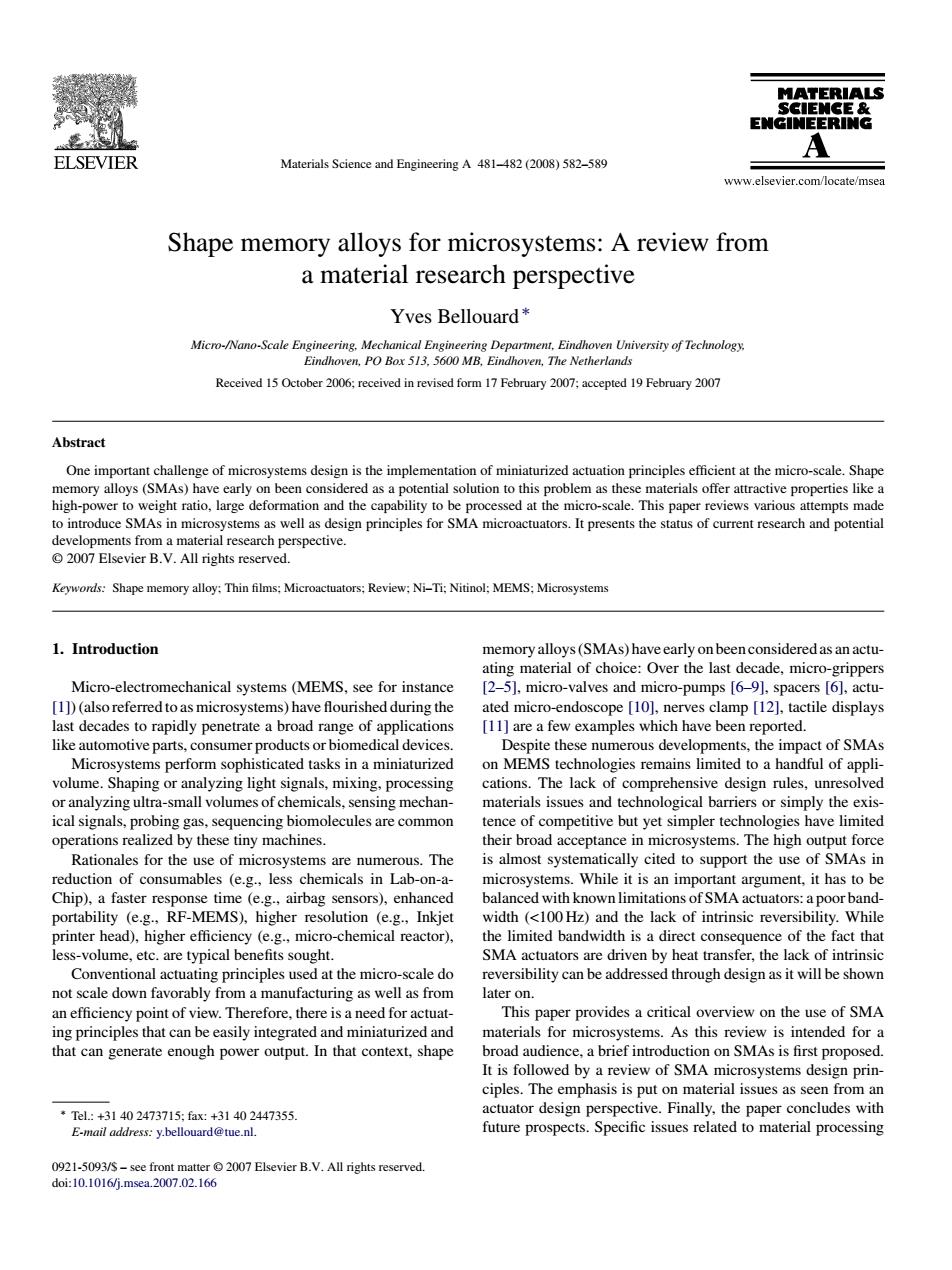正在加载图片...

A ELSEVIER Materials Science and EngineeringA48(28)582-589 www.elsevier.com/locate/mse Shape memory alloys for microsystems:A review from a material research perspective Yves Bellouard* Abstract One imp the imple cight ratio.large deforma ents from rspective Shape memory alloy:Thin ms Review:Ni-Ti Nitinol:MEMS:Microsystems 1.Introduction memory alloys(SMAs)haveearly on beenconsideredas an actu- Mic-ekomhMEMS micro-v valves and ro-pumps [o- like automotive parts,consumer p roductsor biomedical devices. rm sophisticated tasks in a miniaturized mited to a h ical signals,probing gas.sequencing biomolecules are common operations realized by these tiny machines. their broad acceptance in micro ofor the us.The lmost syste while Chip),a faster res nse time (e g airhas sensors)enhanced palanced with known limitations of SMA ctuators:a poor band portability (e.g..RF-MEMS)higher resolution (e.g.Inkje width (<10Hz)and the lack of intrinsic reversibility.While g..micro-chemic eactor mmited bandw direct consequence o ct th not scale down favorably from a manufacturing as well as from later on. This paper provides a critical overview on the use of SMA ded for It is followed by a review of Sma microsystems design prin ciples.The emphasis is put on material issues as seen from a the paper co Materials Science and Engineering A 481–482 (2008) 582–589 Shape memory alloys for microsystems: A review from a material research perspective Yves Bellouard ∗ Micro-/Nano-Scale Engineering, Mechanical Engineering Department, Eindhoven University of Technology, Eindhoven, PO Box 513, 5600 MB, Eindhoven, The Netherlands Received 15 October 2006; received in revised form 17 February 2007; accepted 19 February 2007 Abstract One important challenge of microsystems design is the implementation of miniaturized actuation principles efficient at the micro-scale. Shape memory alloys (SMAs) have early on been considered as a potential solution to this problem as these materials offer attractive properties like a high-power to weight ratio, large deformation and the capability to be processed at the micro-scale. This paper reviews various attempts made to introduce SMAs in microsystems as well as design principles for SMA microactuators. It presents the status of current research and potential developments from a material research perspective. © 2007 Elsevier B.V. All rights reserved. Keywords: Shape memory alloy; Thin films; Microactuators; Review; Ni–Ti; Nitinol; MEMS; Microsystems 1. Introduction Micro-electromechanical systems (MEMS, see for instance [1]) (also referred to as microsystems) have flourished during the last decades to rapidly penetrate a broad range of applications like automotive parts, consumer products or biomedical devices. Microsystems perform sophisticated tasks in a miniaturized volume. Shaping or analyzing light signals, mixing, processing or analyzing ultra-small volumes of chemicals, sensing mechanical signals, probing gas, sequencing biomolecules are common operations realized by these tiny machines. Rationales for the use of microsystems are numerous. The reduction of consumables (e.g., less chemicals in Lab-on-aChip), a faster response time (e.g., airbag sensors), enhanced portability (e.g., RF-MEMS), higher resolution (e.g., Inkjet printer head), higher efficiency (e.g., micro-chemical reactor), less-volume, etc. are typical benefits sought. Conventional actuating principles used at the micro-scale do not scale down favorably from a manufacturing as well as from an efficiency point of view. Therefore, there is a need for actuating principles that can be easily integrated and miniaturized and that can generate enough power output. In that context, shape ∗ Tel.: +31 40 2473715; fax: +31 40 2447355. E-mail address: y.bellouard@tue.nl. memory alloys (SMAs) have early on been considered as an actuating material of choice: Over the last decade, micro-grippers [2–5], micro-valves and micro-pumps [6–9], spacers [6], actuated micro-endoscope [10], nerves clamp [12], tactile displays [11] are a few examples which have been reported. Despite these numerous developments, the impact of SMAs on MEMS technologies remains limited to a handful of applications. The lack of comprehensive design rules, unresolved materials issues and technological barriers or simply the existence of competitive but yet simpler technologies have limited their broad acceptance in microsystems. The high output force is almost systematically cited to support the use of SMAs in microsystems. While it is an important argument, it has to be balanced with known limitations of SMA actuators: a poor bandwidth (<100 Hz) and the lack of intrinsic reversibility. While the limited bandwidth is a direct consequence of the fact that SMA actuators are driven by heat transfer, the lack of intrinsic reversibility can be addressed through design as it will be shown later on. This paper provides a critical overview on the use of SMA materials for microsystems. As this review is intended for a broad audience, a brief introduction on SMAs is first proposed. It is followed by a review of SMA microsystems design principles. The emphasis is put on material issues as seen from an actuator design perspective. Finally, the paper concludes with future prospects. Specific issues related to material processing 0921-5093/$ – see front matter © 2007 Elsevier B.V. All rights reserved. doi:10.1016/j.msea.2007.02.166